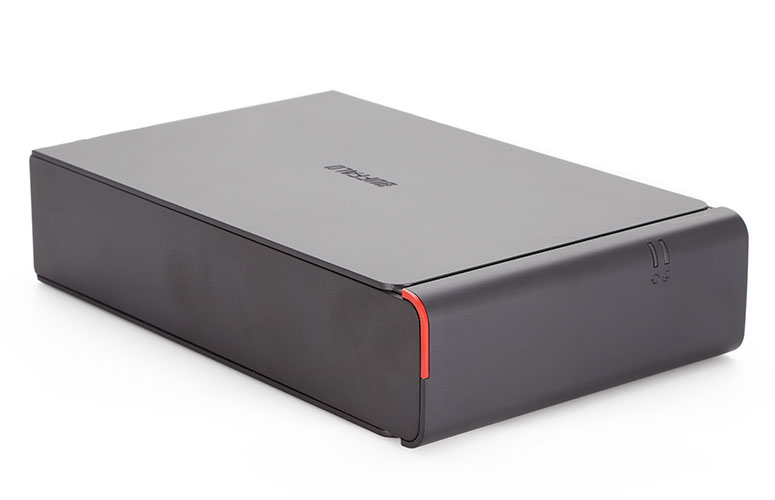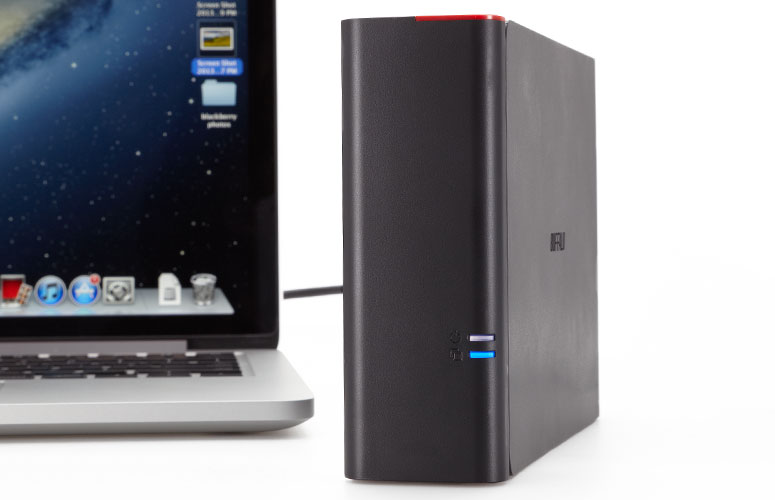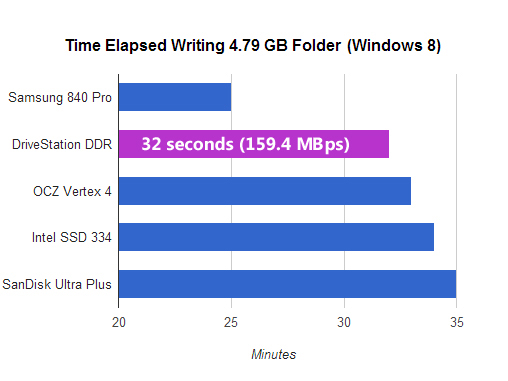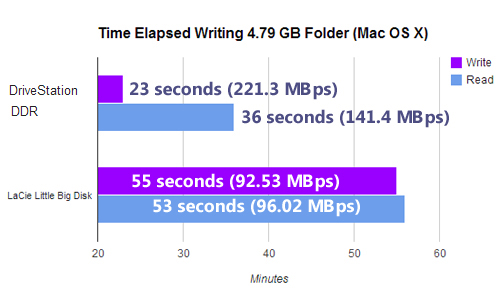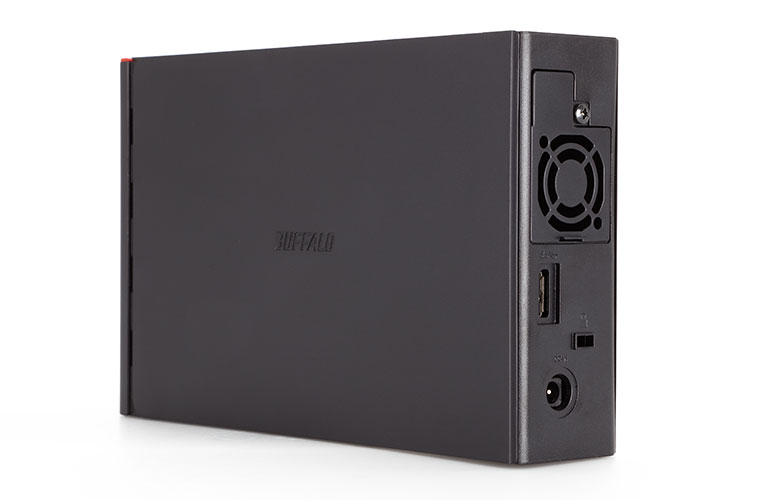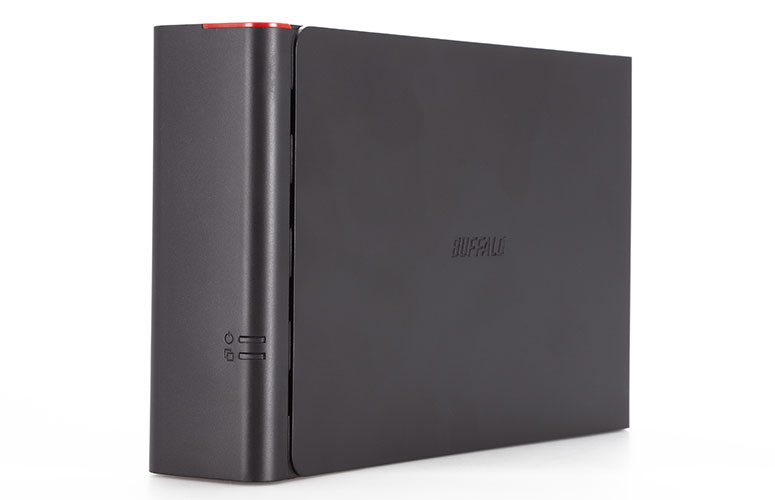Laptop Mag Verdict
The Buffalo DriveStation DDR uses a 1GB RAM cache to make this USB 3.0 hard drive the fastest we've tested.
Pros
- +
Blazing fast read/write speeds
- +
Easy setup
- +
Works with Macs and PCs
Cons
- -
Requires external power supply
Why you can trust Laptop Mag
One of the latest advancements in notebook storage last year was the introduction of hybrid hard drives, which combined a small SSD with a mechanical hard drive to enable faster app open times and startups. Buffalo has taken this a step further with the DriveStation DDR, an external hard drive that uses a 1GB DDR3 RAM cache to complement its 2TB hard drive, to enable superfast read and write speeds over USB 3.0. At $170, this device is a bargain for multimedia hoarders and graphic artists. Find out why the DriveStation DDR is one heck of a backup plan.
Design
Click to EnlargeLike most external hard drives, the DriveStation DDR is unassuming, and designed to blend into the background. Its matte black plastic exterior is accented only by a small red strip along the top front edge and two blue status lights.
Long and thin, the DriveStation DDR measures 7.75 x 4.96 x 1.77 inches, and weighs 2.2 lbs. On the back is a USB 3.0 port, the power jack and a Kensington lock slot. This drive isn't meant to go with you, but you can move it fairly easily from room to room.
Although it could potentially run on bus power alone, the DriveStation must remain plugged into an outlet, so that the data stored in the RAM isn't lost.
MORE: What's the Fastest Cloud Storage Service?
Setup
Sign up to receive The Snapshot, a free special dispatch from Laptop Mag, in your inbox.
Getting the DriveStation DDR up and running is a simple affair. Just plug the power cord into an outlet, and the USB 3.0 cord into a notebook. The drive was recognized instantly on a PC as well as a Mac. After you plug it in, you have the option of installing the utilities that Buffalo includes on the drive.
Features
Click to EnlargeThe DriveStation DDR comes with a number of tools common to Buffalo's external hard drives. They include a Backup Utility, eco Manager (which regulates power consumption), RAMDISK (which lets you use your notebook's RAM as storage), and SecureLock (which you can use to encrypt your files). The DriveStation is also compatible with Apple's Time Machine.
A Cache Control tool, available for both Mac and Windows users, lets you determine whether the drive uses the RAM cache for reading, writing or both.
MORE: Triple Your Speed: How to Install an mSATA SSD Boot Drive in Your Laptop
File-Transfer Tests
To test the DriveStation DDR, we connected it to a Lenovo ThinkPad X1 Carbon Touch running Windows 8. We copied a 4.97GB folder of multimedia to the DriveStation in 32 seconds -- a rate of 159.4 MBps. When compared to internal SSDs, it's not as fast as the Samsung 840 Pro SSD, which took 25 seconds to complete the same task, but it beat the OCZ Vertex 4 (33 seconds), the Intel SSD 334 (34 seconds) and the SanDisk Ultra Plus (35 seconds).
We then copied that same 4.97GB folder back to the X1. This operation took 40 seconds -- a rate of 127.2 MBps.
The DriveStation performed even better when it came to individual files -- even large ones. We copied a single 2.36GB MP4 video to the DriveStation in 9 seconds -- a rate of 268.5 MBps. Copying that same file off the drive took just 13 seconds, or 186 MBps.
MORE: How to Replace Your MacBook Pro's Hard Drive with an SSD
After reformatting the drive to Mac OS X Extended, we ran the file-transfer test while the device was connected to a 13-inch MacBook Pro with Retina Display. It took 36 seconds to copy our 4.97GB folder from the DriveStation to the Mac -- a rate of 141.4 MBps. In comparison, it took the LaCie Little Big Disk 53 seconds to copy that same folder via Thunderbolt to a 15-inch MacBook Pro. While it's not an apples-to-apples comparison, it's still a remarkable time.
Even better, it took just 23 seconds to write the 4.97GB folder to the DriveStation -- a rate of 221.3 MBps. It took the LaCie drive 55 seconds -- more than twice as long.
CrystalDiskMark performance
Click to EnrgeWe also tested the drive using CrystalDiskMark 3.0.2, a synthetic test that measures read and write speeds by transferring a 1000MB file in sequential, 512K and 4K block sizes. When compared to the internal SSDs we tested previously, the DriveStation's read speeds were significantly lower, but still competitive.
When transferring the file sequentially, the DriveStation managed a read speed of 307.2 MBps, which is significantly below that of SSDs such as the Samsung 840 PRO Series (490.6 MBps), but still fast when compared to mechanical hard drives. Its write rate of 361 MBps is also well below that of the Samsung (462.7 MBps) but above the Intel SSD 335's mark of 325.9 MBps.
Using 512K blocks, the DriveStation's read/write speeds of 297.6/368.1 MBps bested those of the SanDisk Ultra Plus (264.8/366.6 MBps) but couldn't keep up with the read/write speeds of the Samsung SSD 840 PRO (430.1/418.5 MBps).
Performance decreased with smaller 4K blocks. The DriveStation's read/write speeds of 5.2/10.2 MBps were well below those of the worst-performing SSD, the Intel SSD 335 (20.9 / 52.3 MBps).
MORE: How to Turn Your iPhone into a Wireless Storage Drive with Bump
Configurations
Buffalo offers two configurations of the DriveStation DDR. The 2TB version, which we tested, costs $170. A 3TB version will go for $219; Buffalo says street prices for both drives are likely to be lower.
Verdict
Click to EnlargeLet's face it: Thunderbolt hasn't exactly taken off, and SSDs, while dropping in price, are still very expensive for those who need to back up a lot of data. At $170, the Buffalo DriveStation DDR is a cost-effective device for backing up multimedia files quickly. It's more than twice as fast -- and less than half the cost -- of a LaCie Little Big Disk, but features the same amount of storage. The fact that the Buffalo drive uses USB 3.0 instead of Thunderbolt makes it much more versatile, too. Although we wish it were more portable, photographers and movie editors on a budget will love the DriveStation DDR's performance and price.
Buffalo DriveStation DDR Specs
| Capacity | 2 TB |
| Company Website | http://www.buffalotech.com |
| Ports | USB 3.0 |
| Read/Write Speed | Read Speed: 0:40/127.2 Mbps Write Speed (Time/rate): 0:32/159.4 Mbps |
| Size | 7.75 x 4.96 x 1.77 inches |
| Storage Type | USB Hard Drive |
| Weight | 2.2 lbs |
Michael was the Reviews Editor at Laptop Mag. During his tenure at Laptop Mag, Michael reviewed some of the best laptops at the time, including notebooks from brands like Acer, Apple, Dell, Lenovo, and Asus. He wrote in-depth, hands-on guides about laptops that defined the world of tech, but he also stepped outside of the laptop world to talk about phones and wearables. He is now the U.S. Editor-in-Chief at our sister site Tom's Guide, where he oversees all evergreen content and the Homes, Smart Home, and Fitness/Wearables categories for the site..
